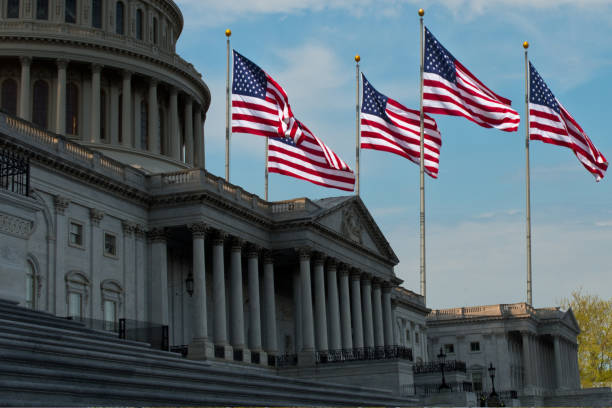- Gold prices rise above $2,360 after Powell’s Senate testimony indicates a cautious approach to rate cuts.
- US 10-year Treasury yield edges up to 4.296%, while DXY gains 0.14%.
- World Gold Council reports second month of ETF inflows, contrasting with PBoC’s pause in Gold purchases.
Gold prices edged up during Tuesday’s North American session after Federal Reserve Chair Jerome Powell appeared at the US Senate Banking Committee and stated that inflation is moving toward the Fed’s 2% goal, yet it is not ready to lower borrowing costs. The XAU/USD trades at $2,364, gaining more than 0.25%.
The golden metal recovered slightly amid elevated US Treasury bond yields and a firm US Dollar. The US 10-year benchmark note coupon climbs one-and-a-half basis points (bps) to 4.296%, while the US Dollar Index (DXY) trends steadily above the 105.00 mark, gaining 0.14%.
Fed Chair Powell stated that “elevated inflation is not the only risk we face,” warning that lowering interest rates too little or too soon could put the economy at risk. He added that while it’s possible to hike rates if the data supports it, the most likely direction would be to “begin to loosen policy at the right moment."
Aside from this, the World Gold Council (WGC) revealed that Gold exchange-traded funds (ETFs) experienced a second month of inflows in June. The WGC stated that total fund holdings rose by around 18 tonnes to 3,106 tonnes.
This contrasts with the People’s Bank of China’s (PBoC) decision not to buy Gold in June as it did in May. China held 72.80 million troy ounces of the precious metal at the end of June.
The US economic docket during the week will feature Powell’s speech at the US House of Representatives on Wednesday, followed by the release of inflation figures on the consumer and producer sides. Initial Jobless Claims and the University of Michigan Consumer Sentiment will complement the schedule.
Daily digest market movers: Gold price advances during Powell’s speech
- US CPI is expected to decrease from 3.3% to 3.1% YoY in June, while core inflation is projected to remain steady at 3.4% YoY.
- According to the consensus, Initial Jobless Claims for the week ending July 6 are expected to increase from 238K to 240K.
- July Consumer Sentiment is set to improve to 68.5, up from 68.2 in June, according to the consensus.
- Federal Open Market Committee (FOMC) June Meeting Minutes revealed that most participants believe the current policy is restrictive but are open to further rate increases. Policymakers acknowledged that the economy is cooling and could respond to unexpected economic weaknesses.
- According to data from the CME FedWatch Tool, investors are pricing in 70% odds of a Fed rate cut in September, up from 73% on Monday.
- December 2024 fed funds rate futures contract implies that the Fed will ease policy by 39 basis points (bps) toward the end of the year.
Technical analysis: Gold price hovers around Head-and-Shoulders neckline
Gold price formed a bearish Harami candlestick pattern after breaching the Head-and-Shoulders neckline, which pushed XAU/USD toward the $2,400 figure before tumbling to the current price level.
Buyers are still in charge with the Relative Strength Index (RSI) standing in bullish territory above the 50-neutral line.
Therefore, Gold’s first resistance would be the July 5 high at $2,392, followed by the $2,400 figure. Further upside is seen, with the next resistance lying at the year-to-date high of $2,450, ahead of the $2,500 mark.
Conversely, if XAU/USD slumps below $2,350, the golden metal might decline to the $2,300 level. If this support fails, the next demand zone would be the May 3 low of $2,277, followed by the March 21 high of $2,222.

Fed FAQs
Monetary policy in the US is shaped by the Federal Reserve (Fed). The Fed has two mandates: to achieve price stability and foster full employment. Its primary tool to achieve these goals is by adjusting interest rates. When prices are rising too quickly and inflation is above the Fed’s 2% target, it raises interest rates, increasing borrowing costs throughout the economy. This results in a stronger US Dollar (USD) as it makes the US a more attractive place for international investors to park their money. When inflation falls below 2% or the Unemployment Rate is too high, the Fed may lower interest rates to encourage borrowing, which weighs on the Greenback.
The Federal Reserve (Fed) holds eight policy meetings a year, where the Federal Open Market Committee (FOMC) assesses economic conditions and makes monetary policy decisions. The FOMC is attended by twelve Fed officials – the seven members of the Board of Governors, the president of the Federal Reserve Bank of New York, and four of the remaining eleven regional Reserve Bank presidents, who serve one-year terms on a rotating basis.
In extreme situations, the Federal Reserve may resort to a policy named Quantitative Easing (QE). QE is the process by which the Fed substantially increases the flow of credit in a stuck financial system. It is a non-standard policy measure used during crises or when inflation is extremely low. It was the Fed’s weapon of choice during the Great Financial Crisis in 2008. It involves the Fed printing more Dollars and using them to buy high grade bonds from financial institutions. QE usually weakens the US Dollar.
Quantitative tightening (QT) is the reverse process of QE, whereby the Federal Reserve stops buying bonds from financial institutions and does not reinvest the principal from the bonds it holds maturing, to purchase new bonds. It is usually positive for the value of the US Dollar.








